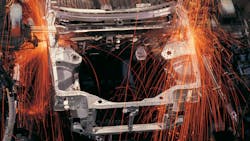US Manufacturing Economy: One Size Does Not Fit All
Does a rising tide lift all boats? One veteran industry observer says with respect to manufacturing, it's getting harder to make that case.
“We’ve evolved into a sector-driven economy,” says Steve Menaker, the national consumer and industrial products team leader at RSM US, the tax and consulting services firm formerly known as McGladrey. “No longer can you assume that when the economy is moving along, everyone is participating.”
For example, he notes that the energy exploration market is “ugly.” He cites a client who is a manufacturer of heavy equipment for the mining industry.
“They were planning three years ago for the neverending storm of doubling their business,” he observes. “Now they are facing declining sales.” He says company leaders are exploring whether they can move into a sector that is doing well, such as automotive or aerospace.
Menaker, who has spent 33 years in public accounting and works with a variety of small to mid-size manufacturing firms, says companies should consider selling into more than one sector in order to avoid becoming too dependent on one large customer or one cyclical industry.
Another potential threat to manufacturers is commodity pricing, Menaker points out. A client that manufactures screw clamps used on engine hoses and other products uses a substantial amount of nickel. The company used a hedging contract to guard against price increases in nickel but with the slowdown in manufacturing activity in China, he said, the price of nickel is falling and the company is actually losing money on the contract.
The immediacy of information about materials costs is also impacting companies, he points out, and putting pressure on the profitability of U.S. manufacturers. He noted a client that contracts for bedding with a manufacturer in Asia. A sophisticated customer recognized that the price of cotton has fallen and contacted the U.S. firm about its order.
“He reaches out and says, ‘We need some price adjustment because the price of cotton is going down,’” says Menaker. “All this information is transparent and available and people are using it to their advantage.”
Asked about the investment climate, Menaker said many companies have the capital and access to funding to make investments, but they are doing so only if they can make a strong financial case for the investment. He says that relates to both the measured pace of growth in the United States and a world economy that is not growing at the rapid pace that had once been expected.
“Until people are convinced we are going in the right direction, they are not going to go too far out,” Menaker says.
That view was reflected in the latest Business Roundtable CEO economic outlook index, which declined 6.6 points to 67.5, the lowest level in three years. For the first half of 2016, CEOs responding to the survey forecast sales to decrease 3.2 points and capital expenditures to decline 16.7 points.
“Lower expectations for sales and investment reflect CEOs’ ongoing caution about the near-term prospects for U.S. economic growth,” said Randall Stephenson, chairman of Business Roundtable, and chairman and CEO of AT&T Inc.
In this cautious environment, says Menaker, companies have been more focused on maintaining and growing their bottom line. He points to a customer that manufactures tires for the agriculture and off-road markets. Though its revenue will be down significantly in 2015, the company’s profits will be up.
“We are now seeing companies selling less and making more because there is a laser focus on managing the entire supply chain and distribution chain for a company,” Menaker states. “If you are not focused on that, you are losing in this market.”
In an uncertain global economy, companies are naturally attracted to stable, growing markets and that is good news for the United States. Menaker notes that companies such as BMW, Kia and Hyundai are investing in U.S. plants and that opens opportunities for smaller firms in the supply chain.
But foreign interest in the U.S. market also brings additional competition to domestic manufacturers. In an annual survey gauging middle market sentiment conducted by RSM and released in July, 67% of the non-U.S. manufacturers reported they intend to sell products or services outside their home markets in 2015. More than half of those said they were targeting the U.S.
About the Author
Steve Minter
Steve Minter, Executive Editor
Focus: Leadership, Global Economy, Energy
Call: 216-931-9281
Follow on Twitter: @SgMinterIW
An award-winning editor, Executive Editor Steve Minter covers leadership, global economic and trade issues and energy, tackling subject matter ranging from CEO profiles and leadership theories to economic trends and energy policy. As well, he supervises content development for editorial products including the magazine, IndustryWeek.com, research and information products, and conferences.
Before joining the IW staff, Steve was publisher and editorial director of Penton Media’s EHS Today, where he was instrumental in the development of the Champions of Safety and America’s Safest Companies recognition programs.
Steve received his B.A. in English from Oberlin College. He is married and has two adult children.
